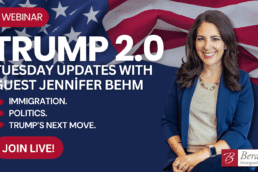PERM is a U.S. Department of Labor (DOL) Program, which stands for Program Electronic Review Management. There are three steps in acquiring a PERM labor certification:
- Step 1: Prevailing Wage Determination (PWD) Request;
- Step 2: Placing Ads and Recruiting; and
- Step 3: Filing ETA Form 9089.
During Step 2, sponsoring employers must engage in a series of good faith recruiting steps, meaning they must make a good faith effort to first hire “able, willing, qualified, and available” U.S. workers, even if the employer already has a temporarily-admitted foreign national occupying the position. Employers are also required to contact and consider all company workers who have been laid off in a same or similar occupation in the area of intended employment. If no such U.S. worker is found through good faith recruitment, then an employer can file a PERM labor certification application on ETA Form 9089 on behalf of a beneficiary.
What is “Good Faith” Recruitment?
The DOL has held that “good faith” recruitment requires that an employer’s process for considering U.S. workers who respond to certification-related recruitment closely resembles the employer’s normal consideration process. Good faith means various things depending on the nature of the recruiting undertaken; thus, some recruitment methods may be considered more appropriate than others depending on the requirements for the position.
The DOL will deny an application if it finds that the employer is not acting in good faith. The following is a list of examples on what employers should not do when recruiting:
- Advising an applicant that the position is not really open because there is an existing company employee already in the job. Employers must treat the position advertised as fully open even if it is currently filled by an employee holding temporary visa status (such as H-1B, L-1B);
- Allowing the sponsored foreign national employee to be involved in the recruiting and applicant assessment process, including but not limited to, reviewing and critiquing the resumes of job applicants;
- Following a course of action different from the normal course of action in terms of evaluating and handling applicants. Resumes should be screened and any interviews should be conducted by the company personnel – whether human resources, recruiters or line managers, or a combination thereof – that normally would do this; or
- Discarding resumes of job applicants. The employer in a PERM case must retain all resumes and provide copies of them to us, even from applicants who are not qualified.
Key Factors in “Good Faith” Recruitment
An important part of good faith recruitment is timeliness. First, it is recommended that employers place all of their job advertisements at the same time, if possible. The reason for this is that all of the advertisements must be less than 180 days old at the time of filing the PERM application. If one of the advertisements is older than 180 days, that advertisement cannot be used for the PERM, and the employer will need to place another ad before filing the PERM. Second, employers must consider all applicants in a timely manner. Employers who delay reviewing applicants’ resumes or who are slow to respond to U.S. worker applicants risk having their applications denied. Therefore, employers musty quickly review any resumes they receive to determine whether or not the applicant possesses some, all, or none of the qualifications specified. It is suggested that employers do this at least once a week.
Another important part of good faith recruitment is identifying applicants who require follow-up attention. The employer may need to speak on the telephone with some or all applicants who appear to meet many of the job’s requirements. In some cases, the applicants might need to be invited in for an interview. Only applicants who (1) appear qualified or (2) whose resumes suggest that the employer should inquire further will merit particularized attention. If an employer determines that the applicant does require follow-up attention, it must be done as soon as they receive the applicant’s resume. It is important to log the date and time of all attempts to reach applicants. Those applicants who clearly lack the qualifications required for the advertised job will not need to be contacted by phone nor will they need to be interviewed.
When reviewing applications, the DOL requires employers to focus on the “hard” requirements of the skill set elements relating to education and experience instead of the “soft” requirements such as personality, ability to work as a team, or the strength of references. Relying on soft factors to reject a U.S. worker may result in an audit by DOL. Note that employers must also consider a U.S. worker who can acquire the skills necessary to perform the job during a reasonable period of on-the-job training as qualified for the position.
An Attorney’s or Agent’s Role in the Recruiting Process
Generally, the DOL has held that attorneys, agents, and foreign workers are prohibited from interviewing and considering U.S. workers during the permanent labor certification process but are not prohibited from performing the analyses necessary to counsel their clients on legal questions that may arise with respect to this process. The employer, and not the attorney or agent, must determine whether a U.S. applicant’s credentials meet the minimum qualifications for the position, unless the attorney or agent is the representative of the employer who routinely performs this function for positions for which labor certifications are not filed.
After an employer evaluates a U.S. worker and concludes that the worker is unqualified, the employer may seek the advice of its attorney or agent to ensure that its reasons for rejecting the U.S. worker are lawful, and the attorney or agent may review the qualifications of the U.S. worker to the extent necessary to provide that advice. By contrast, if an employer evaluates a U.S. worker and determines that the worker is minimally qualified, the attorney, agent, or foreign worker may not thereafter consider the applicants’ qualifications and attempt to substitute his or her own judgment for that of the employer.
If the DOL finds evidence of potentially improperattorney, agent, or foreign worker involvement in considering U.S. worker applicants, the DOL may audit applications to determine whether the employer’s recruitment and hiring processes were conducted in good faith and to ensure adherence to all statutory and regulatory requirements.
Interviewing Applicants
During an interview it is important for the employer to take good notes regarding statements made by the applicant which establish that the applicant either meets or lacks the qualifications required for the position’s skill set.
If an employer’s recruiting efforts yields a qualified U.S. worker who is interested in the position on the stated terms, then the employer can elect to hire the worker. Note that the employer is not required to terminate the foreign national subsequently. If the employer elects to hire the U.S. worker, then they will not be authorized to file a PERM application because filing such an application equals a representation to the DOL that they were unable to locate any qualified, interested, and available U.S. workers. It is important to note that the employer may initiate a new recruiting process at a later time if they elect to.
If an employer’s recruiting efforts yield no qualified U.S. workers, then they must prepare a summary to the DOL that describes the recruitment steps undertaken and the results achieved, the number of hires, and, if applicable, the number of U.S. workers rejected, categorized by the lawful job-related reasons for such rejections. The DOL Certifying Officer, after reviewing the report, may request the U.S. workers’ resumes or applications, sorted by the reasons the workers were rejected.
The recruiting report must be signed by the employer’s representative who normally interviews or considers, on behalf of the employer, applicants for job opportunities such as that offered to the foreign national, but which do not involve labor certification. PERM applications are filed under penalty of perjury, so it is important that the employers confirm that all representations made to the DOL are backed up by facts and that the recruiting summary adequately summarizes all representations. The recruiting file must be in place before the PERM application is filed with the DOL. In the event of an audit by the DOL, the employer must be ready to send all requested evidence to the DOL within 30 days.
In sum, an employer must take steps to demonstrate that they are complying with the DOL’s PERM rules by engaging in “good faith” recruitment efforts of qualified U.S. workers.
If you have questions on the PERM process, be sure to contact our firm to schedule a consultation with one of our attorneys today!
Related Posts
December 15, 2025
How the New $100K H-1B Fee Reshapes Hiring for Canadian Physicians
December 10, 2025
Webinar: “Trump 2.0: Tuesday Updates With Guest Jennifer Behm”
Ready to have Berardi on your side?
Whether you’re a business looking to hire or a professional hoping to relocate, immigration law can be complicated. But you don’t have to do it alone. Put our experience to work for you.



